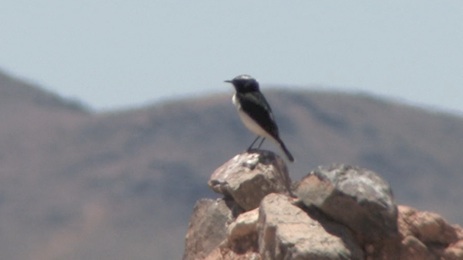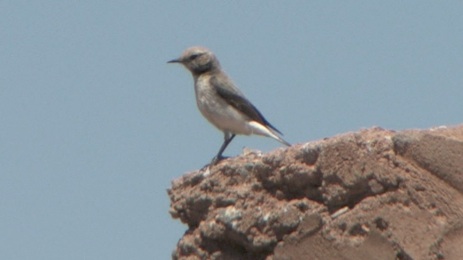Birds Near and Far
Home books dvds apps sites extra maps links contact us blog Buy
Birds Near and Far
Home books dvds apps sites extra maps links contact us blog Buy
A blog by Dave Gosney about some of the birds and places that feature in his books and DVDs but also about the state of birds in the Sheffield area

3rd April 2014
Finding Magreb Wheatear
Maghreb Wheatear on ‘Wheatear Wall’, Boumalne, Morocco April 2009. This site has not been occupied since then - so where should you look now?
My book 'Finding Birds in Morocco: the deserts' lists 5 sites for Mourning Wheatear, a form which has since been split and re-named as Maghreb Wheatear (Oenanthe halophila). The trouble is, at most of those sites birds were found one year but never again so I was delighted to report a 'regular breeding site' at 'Wheatear Wall' on the Tagdilt track. This seemed like a good idea as a pair were present here, and easy to find, for 4 successive years but, as soon as my book had been published, they disappeared from this site.
Maghreb Wheatear on ‘Wheatear Wall’, Boumalne, Morocco April 2009. The sullied grey crown (instead of pure white) and grey-black back (instead of jet black) suggest this male had one parent of a different wheatear species, perhaps Seebohm’s (O. seebohmi)
So here are some updated thoughts on how to find Maghreb Wheatear.
I should start by admitting that I still don't know a site where they can be pretty much guaranteed. It is still the case that one of the best ways of seeing them is to 'fluke' one by the roadside. As described in my book, you should keep an eye open as you drive between Amerzgane and Ouarzazate, between Ouarzazate and El Kelaa and between Boumalne and Tinerhir. In the last few years I've had them at 4 locations by the road between Boumalne and Tinerhir, as described in the Finding Birds app; however, as seems to be typical with this species, I've failed to relocate them on subsequent visits to 3 of those sites, even just a week later. Even so, here are some sites where birders have been successful more than once.
Ait Aouida track
This site has proved most reliable for me over each of the last 4 years. Drive east from Boumalne for 36 km until, just after km post 'Er Rachidia 149' you see a track to the left, signposted 'Ait Aouida'. Park at the bottom of this track (31.4394N, 5.6495W) and check the area from the road to the cliffs to the north. The problems in finding these birds may lie in the size of their home range. I've sometimes found them on the plain to the east of the track and in 2014 I had a (the?) male 600 metres further east where the pylons cross the main road.
Amerzgane road
As reported in my book, there have been sightings over a number of years along the P1505 road south of Amerzgane. The road is 10 km long so here are some more precise locations. About half way along the road it becomes dead straight as it crosses a high plateau. With care you can park by a wadi with a lone palm tree (30.9956N, 7.2304W); I've seen them on the plain to the west of the road and there's a report on the app of one close to the road just south of this spot. I've also found them, more reliably, along the last 1.5 km of road before it begins to dip down to Amerzgane. There's a lone bush along this stretch of road (31.0265N, 7.2223W) and I had a male near there in both 2012 and 2013. On 12th March 2014, I found a male by the left hand bend 1 km south of here (31.0190N, 7.2287W) and when I returned a week later there was a pair present and the male seemed to be showing interest in a potential nest hole right by the road.
East of Amerzgane
Guy Anderson found a pair 11.5 km west of Ouarzazate on 6th March 2014 and reported it on the finding birds app. Six days later, I happened to find a pair at the same site (despite not having studied my own app clearly enough to know where Guy had seen them). It's by the main road along the stretch immediately west of km post Amerzgane 22 (= Agdz 82).
Maghreb Wheatear female on ‘Wheatear Wall’, Boumalne, Morocco April 2009. The females usually have a pattern of dark and light that mimics that of the male but with brown, not black on the head, throat and mantle. Not all females have dark throats.
The following sites are where others have seen Maghreb Wheatear but I haven't seen them personally.
Imiter quarry
This is a known site for Pharaoh Eagle Owl but some observers have had Maghreb Wheatear too. The following directions are taken mostly from contributions to the log at the Auberge Soleil Bleu, Boumalne. Drive east from Boumalne for 18 km until you pass km post Er Rachidia 168. Take the next track to the left (31.3789N, 5.8124W) (immediately before a similar track to the right) and follow it until it bends to the right. Park there (31.3743N, 5.8107W) and climb the hill in front of you to scan across the quarry for owls in the cliff on the far side. Returning to the track, follow it on foot into a wadi with scattered bushes and check these for wheatears.
km 48 track
The km post Tinghir 48, just east of Boumalne is one of the landmarks on the map on page 19 of my book. If you turn right here you get to the town dump but if you turn left (north) you can follow a track for 1.5 km as far as a line of pylons. Ray Thorneycroft had 3 Maghreb Wheatears here in 2007 (by pylon number 93) and other contributors to the Soleil Bleu log have also been successful here since then, apparently in the area of '3 caves'. I've never visited this site but Adrian Binns tried it without success in 2014.
Ikniouen orchard
This is site 7 on page 21 of my book. Bob Buckler of Wingspan tours found 4-5 Maghreb Wheatears 'in the rocky areas nearby' in February 2012, and another in March 2012 and Jussi Tranesja had a male on the walled area just above the orchard in March 2014 (finding birds app).
Thanks to all whose sightings have contributed to this summary, especially those who have put detailed information into the free app 'Finding Birds: the latest gen' or in the birders log at the Soleil Bleu.



Blog archive

Maghreb Wheatear, Ait Aouida track, Morocco March 2014. A ‘proper’ male. They lack the peachy vent and pale wing markings found on Mourning Wheatears in Israel.